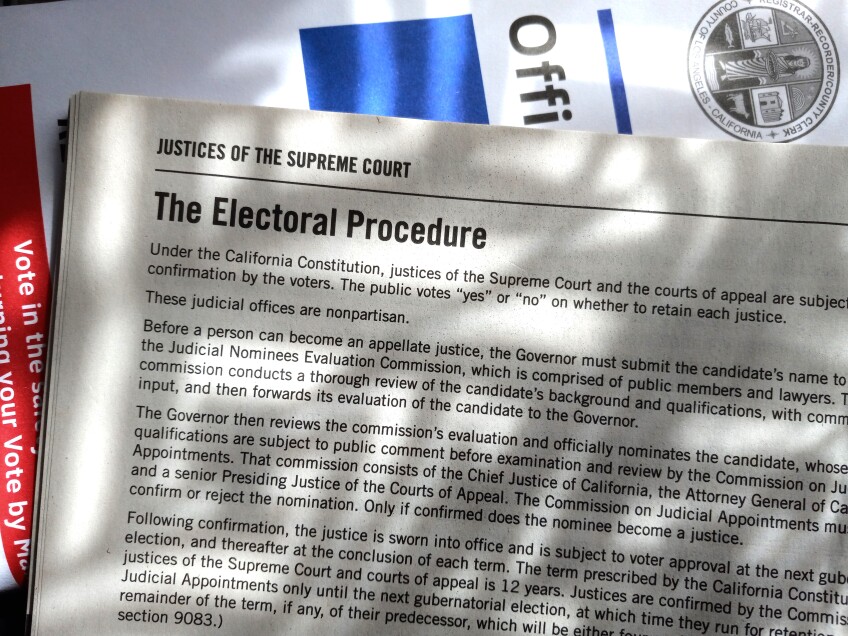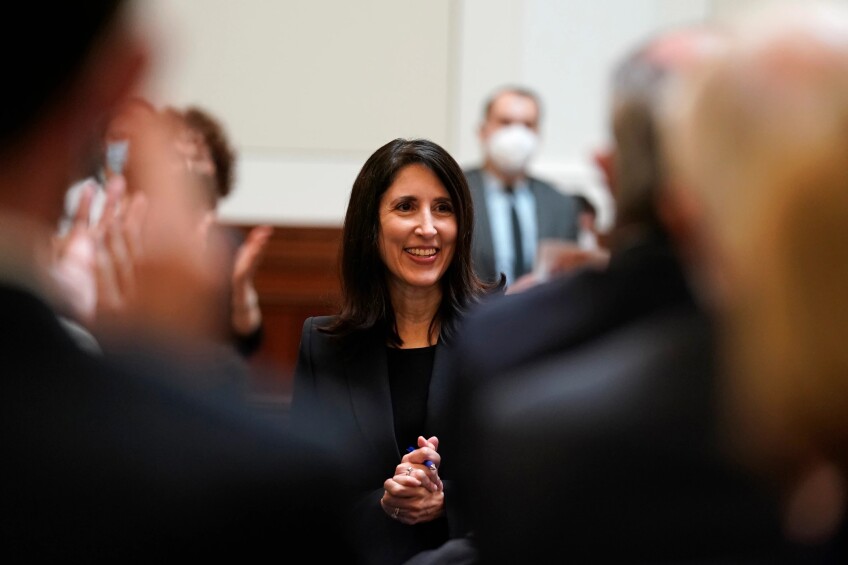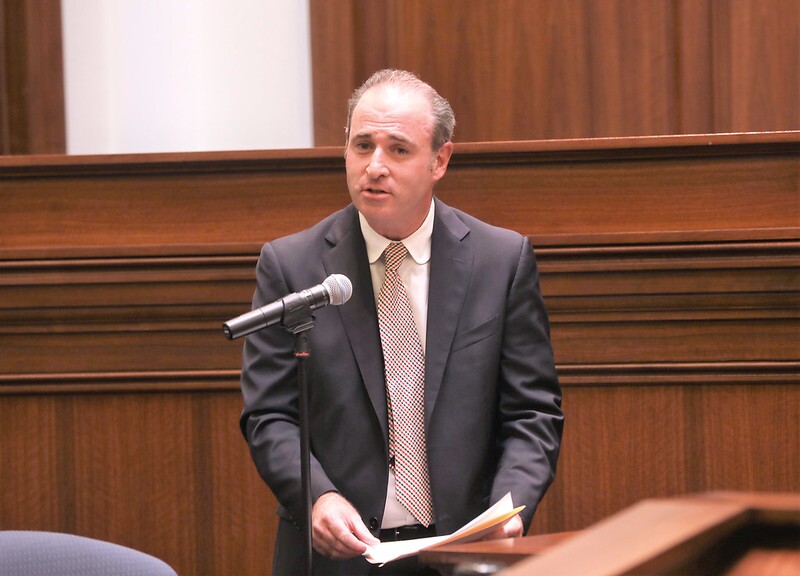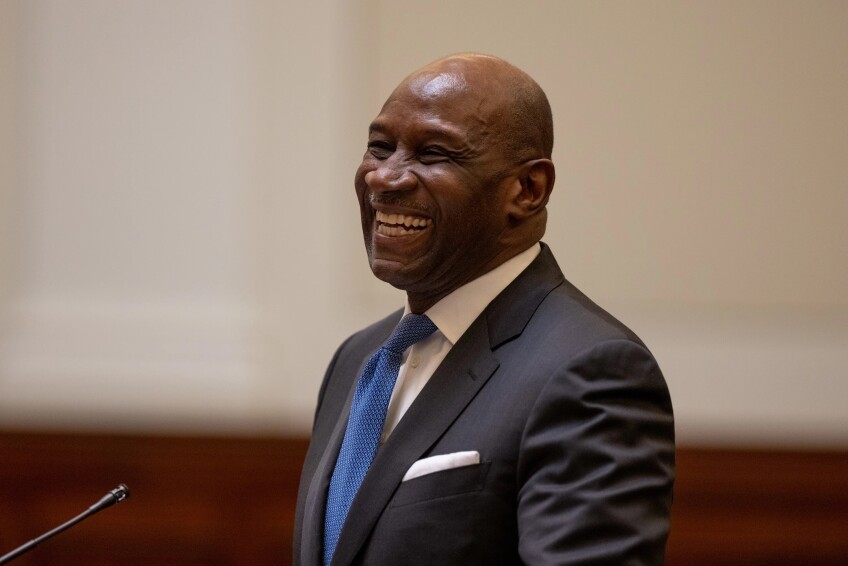Four Justices Vie To Keep Spots on California Supreme Court

It's one of the most diverse, consequential — and unrecognizable — branches of California government.
Name one member of the California Supreme Court.
Thought so.
Yet the names of four justices on California's highest court are appearing on the November ballot, mixed in with more glossy, high-profile candidates.
[The Supreme Court] is being asked to answer the hard questions or find solutions to the really hard issues.Beth Jay, former principal attorney to three chief justices between 1987 and 2015.
In the past three decades, the court has gone from being a lightning rod of controversy to a steady, collegial body shaping California law. Today, the state's highest court — unlike the U.S. Supreme Court — rarely renders opinions that polarize the public, making their appearance on the ballot an afterthought for many California voters.
"I suspect the average voter these days doesn't think about the California Supreme Court, and they don't need to," said David A. Carrillo, executive director of Berkeley Law's California Constitution Center.
It hasn't always been that way. In the mid-1980s, outraged voters ousted Chief Justice Rose Bird over her persistent votes to overturn death penalty cases. Two other associate justices were also voted off the seven-member court.
"Since then," said Carrillo, "the court has returned to its usual calm way of doing the people's business."








This November, Associate Justice Patricia Guerrero is asking voters to select her as chief justice.
Associate Justices Joshua P. Groban, Martin L. Jenkins and Goodwin Liu also are on the ballot seeking to remain on the panel.
In California, appellate and Supreme Court justices are selected through a gubernatorial appointment, confirmation and voter approval process. Superior Court or local judges can either be appointed or directly elected to the bench by voters.
Superior Court judges serve six-year terms. Appellate and Supreme Court justices are elected for 12-year terms.
If a majority of voters say "yes" on a justice, they get a 12-year term. If a majority say "no" on any of the justices, the governor must nominate a replacement. If confirmed by the Commission on Judicial Appointments, the justice would serve until their retention election.
While most cases are heard and decided at the local level, the Supreme Court answers tough legal questions facing Californians.
"By its very place in the judicial hierarchy, [the Supreme Court] is being asked to answer the hard questions or find solutions to the really hard issues," said Beth Jay, former principal attorney to three chief justices between 1987 and 2015.
Under the leadership of retiring Chief Justice Tani Cantil-Sakauye, who was nominated in 2010 by former Republican Gov. Arnold Schwarzenegger, the highest court has become increasingly more in sync.
Since 2011, 85% of the court's decisions have been unanimous, according to data from the California Constitution Center. Before her tenure, 74% of the court's cases were unanimous under former Chief Justice Ronald M. George from 1996 to 2011. George was appointed by Republican Gov. Pete Wilson.
Today’s justices are consistently siding with each other, even as the state Supreme Court has become the most diverse court in the country, according to the Brennan Center for Justice, a nonprofit law and policy institute.
The current bench includes an Asian justice, one Asian-Filipina justice, two Black justices, one Latina justice and two white justices. Four of the seven are women.
In just a few years, Gov. Gavin Newsom's Supreme Court appointments and nominations press releases have touted a series of firsts:
- "California's first Latina Supreme Court Justice."
- "First openly gay California Supreme Court Justice."
- "First Latina to serve as California's Chief Justice."
While some may think the court's ability to agree begins and ends with who appointed them, Cantil-Sakauye says it has more to do with how the court operates. She attributes the court's high unanimity rate to the justices' way of preparing for cases before they hear oral arguments.
"That is key to how we are … collegial and … have an opportunity to write an opinion that most people can agree on," she said.
Unlike the U.S. Supreme Court, Cantil-Sakauye said, she assigns cases to individual justices as soon as the court grants a review. The court doesn't wait until after hearing oral arguments to begin evaluating the case. By the time litigants argue their case, she said, she "tentatively knows" the justices' concerns.
"We have time to work with each other and explore others' positions," she said.
The justices, however, have not always agreed.
One 2018 opinion split the court, 4-3, along ideological lines. The highly-watched case centered around California's requirement that DNA samples be collected during felony arrests. The majority, which included more conservative justices, let the law stand in a win for prosecutors.
The more left-leaning justices sided with civil libertarians, who contended the law violated the state's privacy laws.
Even so, the news coverage and intense arguments in the DNA case paled against the furor that surrounded former Chief Justice Rose Bird and her court.
Bird, the first woman on the Supreme Court and the first female chief justice,was appointed by former Gov. Jerry Brown during his first stint as governor. Bird opposed the death penalty, which emboldened some political factions to lead a campaign against her retention.
By 1986, under Republican Gov. George Deukmejian, voters elected not to retain Bird and associate justices Joseph Grodin and Cruz Reynoso, who also had been appointed by Brown. The turnover created a pathway for Deukmejian to appoint three new justices to the court, suddenly remaking the state's highest court.
"The institution picked itself up, dusted itself off, and kept doing the work," said attorney Jay, who worked for the court at the time.
"The strength of institutions like the court, if it's functioning properly, is that (the court) can continue to function even when it's getting some pretty bad body blows."
This article was originally published by CalMatters.










